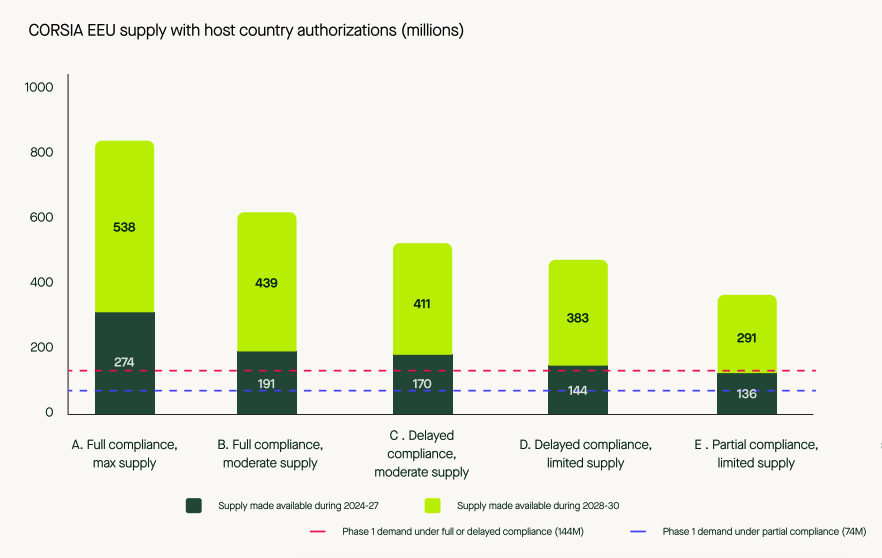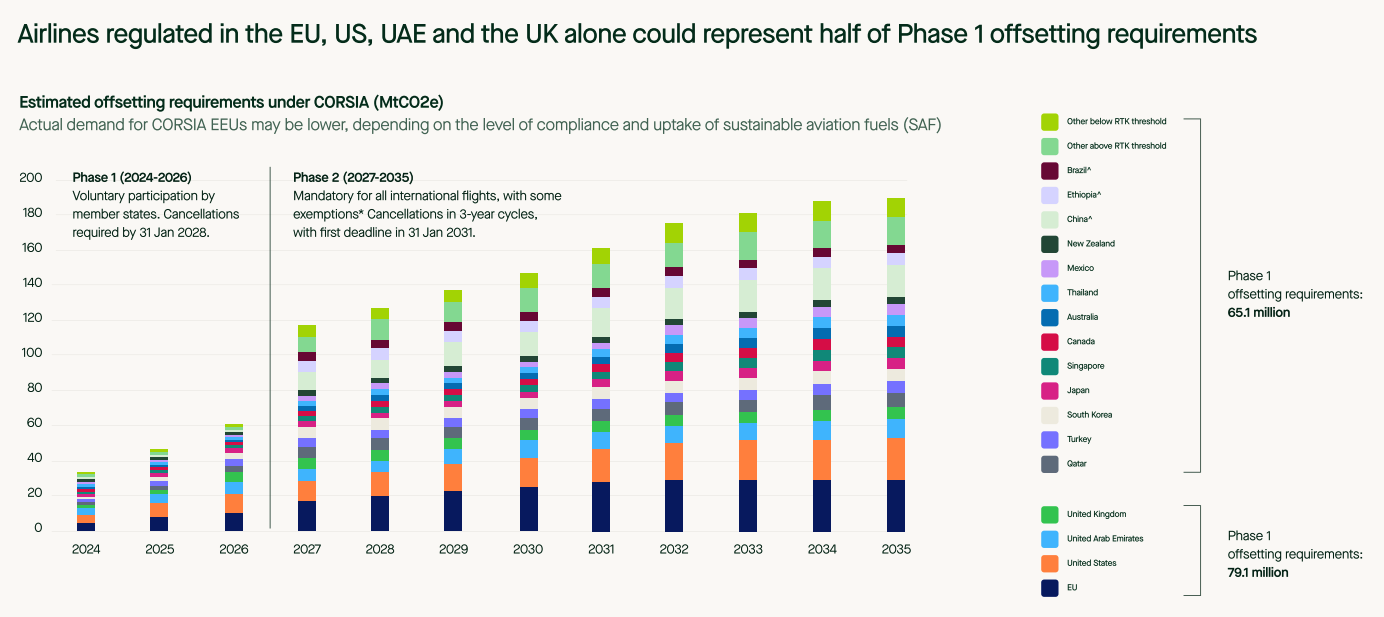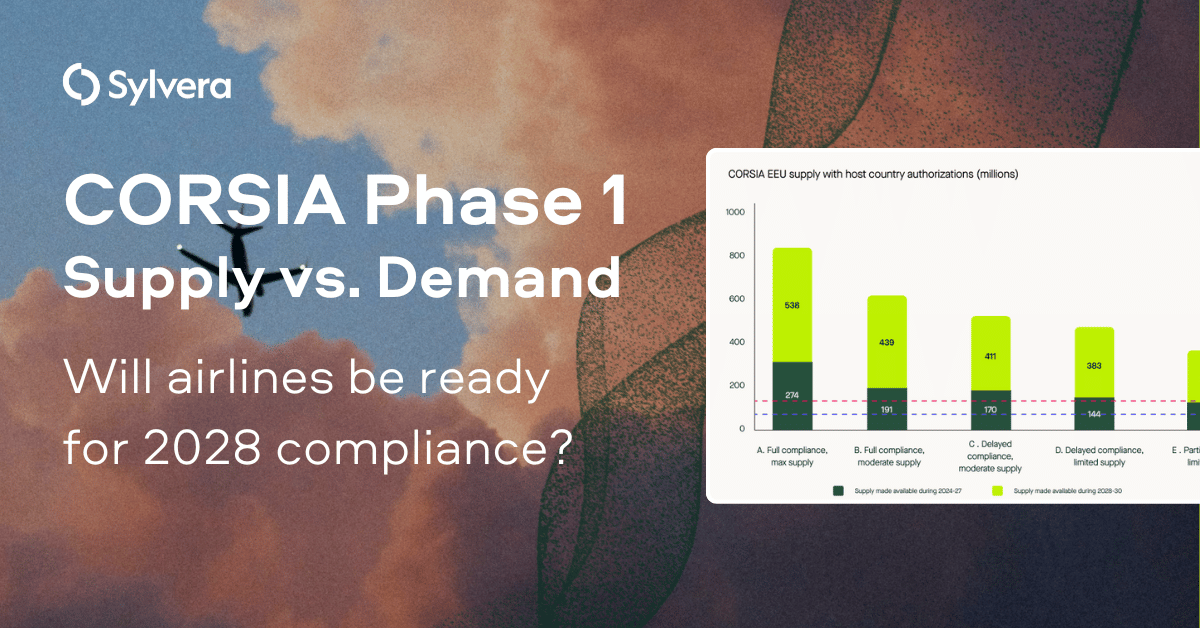“Over the years we’ve invested significantly in our field data team - focusing on producing trusted ratings. While this ensures the accuracy of our Ratings, it doesn’t allow the scale across the thousands of projects that buyers are considering.”
For more information on carbon credit procurement trends, read our "Key Takeaways for 2025" article. We share five, data-backed tips to improve your procurement strategy.

One more thing: Connect to Supply customers also get access to the rest of Sylvera's tools. That means you can easily see project ratings and evaluate an individual project's strengths, procure quality carbon credits, and even monitor project activity (particularly if you’ve invested at the pre-issuance stage.)
Book a free demo of Sylvera to see our platform's procurement and reporting features in action.
How CORSIA compliance is shaping up right now
With just 18 months until CORSIA's First Phase compliance deadline, the aviation industry faces an uncomfortable truth: the market for CORSIA carbon credits barely exists, and compliance readiness remains dramatically underdeveloped globally.
The Carbon Offsetting and Reduction Scheme for International Aviation (CORSIA) was designed to achieve carbon-neutral growth in international aviation from 2020 onward. However, as airlines approach the January 31, 2028 deadline to retire Eligible Emissions Units (EEUs) covering 2024-2026 emissions, both supply availability and compliance frameworks remain uncertain.
This creates what industry experts describe as a "chicken-and-egg" challenge: project developers and host countries need clear demand signals to unlock supply, but demand signals remain muted because airlines are waiting for supply certainty and regulatory clarity on enforcement.
At Sylvera, we conducted an industry-first market modeling to project the feasible outcomes of CORSIA Phase 1, under different supply, demand, and compliance constraints.
CORSIA supply and demand volumes
Supply reality: Severe constraints ahead
Current available supply: As of June 2025, only 15.84 million CORSIA-eligible credits have been issued—all from Guyana's jurisdictional REDD+ program. When these credits were auctioned in late 2024 at $21.70 per unit, only 11 airlines purchased fewer than 400,000 credits, highlighting the market's nascent state.
Potential vs. accessible supply: While over 4,000 projects across ICAO-approved registries could technically supply EEUs, the reality is far more constrained. Only approximately 1,500 projects are located in the 16 countries that demonstrate moderate readiness for Article 6 authorizations under the Paris Agreement.
Supply projections: Market modeling suggests CORSIA EEU supply could range dramatically:
- Maximum scenario: 274 million EEUs by end of 2027 (assumes 30+ countries ready to authorize)
- Moderate scenario: 170-191 million EEUs (assumes 15+ countries ready)
- Constrained scenario: Just 136-144 million EEUs (assumes only 7 countries provide authorizations)
The wide range reflects the fundamental uncertainty around host country willingness and capacity to provide the necessary authorizations with corresponding adjustments.

Demand uncertainty: Will airlines actually comply?
Theoretical demand: If all airlines in participating jurisdictions comply with CORSIA offsetting requirements, First Phase demand would reach 144 million EEUs. Airlines regulated in just four regions—the EU, US, UAE, and UK—could represent half of this demand.
Compliance reality check: Despite 129 countries voluntarily participating in CORSIA's First Phase, compliance readiness tells a different story:
- Out of 36 countries responsible for 90% of international aviation emissions, fewer than 15 have indicated willingness to implement CORSIA through national regulation
- The top two emitters, China and the USA, have not confirmed their intention to enforce the scheme
- Most countries have not yet defined rules around CORSIA enforcement in their jurisdictions
Expert consensus: A survey of 40+ policy and market experts revealed that partial compliance with limited supply is considered the most likely outcome, with this scenario receiving 31% of expert votes. Combined with delayed compliance scenarios, over half of experts expect supply constraints to significantly impact CORSIA implementation.

The authorization bottleneck
The most critical constraint isn't project availability—it's host country authorizations. Under Article 6 of the Paris Agreement, countries must authorize carbon credit exports and implement corresponding adjustments against their Nationally Determined Contributions (NDCs).
Current Status: Only Guyana has successfully completed this process for CORSIA-eligible credits. Most other potential host countries lack the institutional frameworks, technical capacity, or political willingness to authorize credit exports at scale.
Expert Assessment: When asked to rank six key uncertainties facing CORSIA, 59% of experts voted "volume of credits with authorizations and corresponding adjustments" as either the most or second-most important concern—far exceeding worries about credit integrity, enforcement, or EU endorsement.
Strategic tips for airlines to prepare for variable CORSIA supply
1. Assess your compliance exposure
Airlines should immediately evaluate their specific offsetting requirements under different compliance scenarios. Even carriers in jurisdictions without clear enforcement may face competitive pressure to demonstrate CORSIA compliance voluntarily.
Key questions:
- What are your projected excess emissions for 2024-2026?
- How does your regulatory jurisdiction plan to enforce CORSIA?
- What reputational risks exist from non-compliance even without legal requirements?
2. Monitor supply development actively
Given supply constraints, airlines should track host country authorization progress closely. Countries developing Article 6 frameworks directly impact credit availability from projects in their territories.
Priority monitoring:
- Track the 16 countries showing moderate Article 6 readiness
- Monitor JREDD+ program developments (particularly ART TREES and Verra programs)
- Watch for PACM credit program launches, which could provide significant supply
3. Prepare for multiple scenarios
Airlines should develop contingency plans for different supply-demand outcomes:
- Full compliance scenario: Secure 144 million EEUs collectively across industry
- Partial compliance scenario: Plan for 74 million EEUs with regional enforcement focus
- Delayed compliance scenario: Prepare for potential deadline extension to January 2030
CORSIA compliance approaches
With CORSIA supply development requiring 12-24 months for authorization processes and credit issuance, the window for addressing supply-demand imbalances is rapidly closing. Airlines that begin compliance planning now position themselves to navigate whatever market conditions emerge. Those who wait risk facing acute supply shortages and premium pricing as the deadline approaches.
The question isn't just whether airlines will be ready for CORSIA compliance—it's whether the entire market infrastructure will exist to enable compliance at scale.
Get the Complete CORSIA Market Analysis
This supply-demand challenge is a key focus as part of Sylvera's industry-first CORSIA First Phase Scenario Modeling report, based on consultations with 40+ industry experts and detailed market modeling across six implementation scenarios.
Download the full report for complete supply projections, country-by-country readiness assessments, detailed compliance scenarios, and strategic recommendations for navigating CORSIA market development.

Helping airlines navigate CORSIA complexity
With deep expertise in both carbon markets and policy, Sylvera provides the critical intelligence and tools needed to succeed in the evolving CORSIA landscape.
Strategic CORSIA compliance & market intelligence
Our policy experts help airlines, investors, and carbon market participants develop robust CORSIA compliance strategies by providing realistic assessments of market scenarios and regulatory developments. We help you navigate uncertainty and position for action before prices rise, ensuring your strategies remain resilient across multiple scenarios.
End-to-end support
From initial discovery through rigorous due diligence to ongoing monitoring, Sylvera supports your complete journey with CORSIA-eligible credits. Our trusted ratings provide deep project-level analysis to assess true quality and risk. With limited supply and intensifying demand for CORSIA-eligible credits, we help you identify high-quality opportunities in this nascent market.
Data-driven decision making
Having reliable data and insights is crucial for informed decision-making. Sylvera's Market Data provides real-time market intelligence, and our in-house scenario modeling helps you take low-risk climate action.
If you need expert guidance in navigating CORSIA, our team is ready to help. Get a free Sylvera demo here.









.png)





